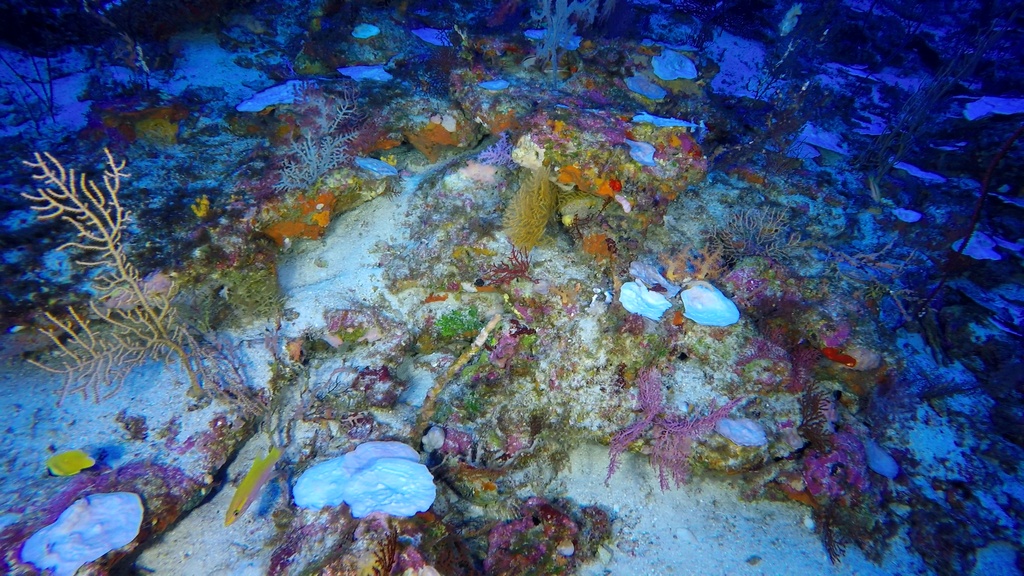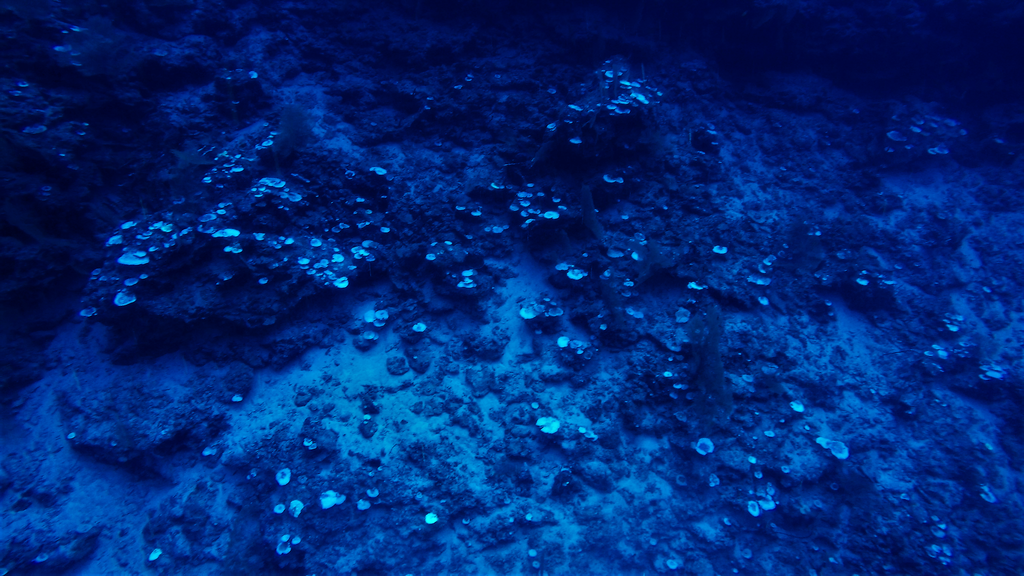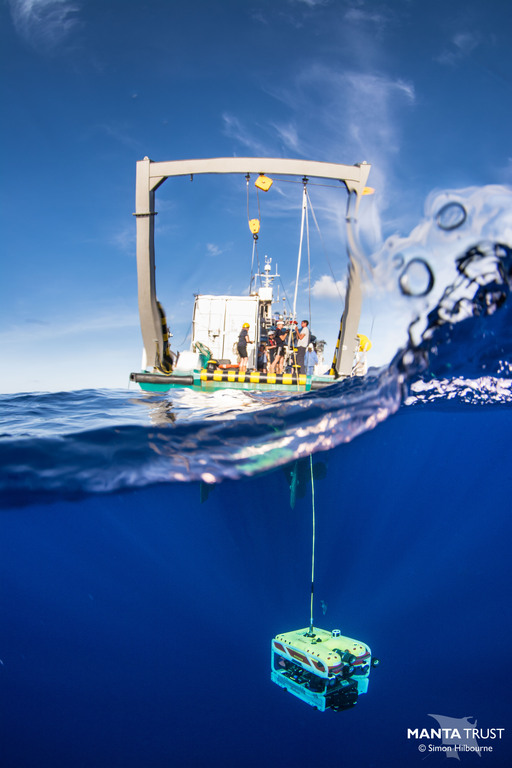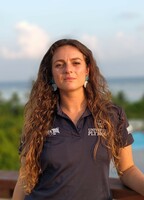Behind the science:
Mesophotic coral bleaching associated with changes in thermocline d...
2024, April 21
Posted by Veronica Radice
Fields
Climate Change
Disturbances
Oceanography
Focusgroups
Scleractinia (Hard Corals)
Locations
Chagos Archipelago
Platforms
In-situ instrumentation
Remotely Operated Vehicle (ROV)
“Thermocline depth and bleaching of mesophotic corals in Chagos, Indian Ocean”
How do you pronounce “mesophotic” – ‘mee-so’ or ‘meh-so’ -photic?
Haha, I’ve actually never thought about it… Both I think, depending on the day probably and if I’m talking English or French.
Are you more interested in charismatic megafauna or scouring the benthos for cool creatures?
Benthos all in! Even if I love the biggies too, of course.
 Bleached plate corals Leptoseris spp at 80 m depth (Sandes seamount).
(C) University of Plymouth
[CC BY-NC 4.0]
Bleached plate corals Leptoseris spp at 80 m depth (Sandes seamount).
(C) University of Plymouth
[CC BY-NC 4.0]
 Widespread bleaching of mesophotic plating corals (Leptoseris spp) at 90 m depth in Egmont Atoll.
(C) University of Plymouth
[CC BY-NC 4.0]
Widespread bleaching of mesophotic plating corals (Leptoseris spp) at 90 m depth in Egmont Atoll.
(C) University of Plymouth
[CC BY-NC 4.0]
What was the most challenging aspect of your study (can be anything from field, lab to analysis)?
Working in the middle of nowhere. Whilst it’s an absolute privilege to be in remote areas, working with expensive equipment at a minimum of two days away from the nearest port is not the easiest. You must think about every detail before embarking, because you know that you won’t be able to get anything for at least a month. This is true workwise, bringing the right amount of spare equipment in case anything breaks, but at the same time not too much as shipping is expensive and space on the ship is precious. This is also true personally-wise, to make sure that you have seasick tablets when the sea is rough (hi cyclones on a flat-bottom boat) for example; or that you bring your favourite food/snacks to compensate for the lack of fresh food during the last weeks; oh, and also, forget about having some personal space during this time… It may not look attractive now, but it’s actually such an enriching experience, which I would do over and over again!
What was the most memorable moment in undertaking this study?
I would say basically every ROV dive we did during our first expedition; it was just amazing to see so much life down there and thinking that we were the first ones to see mesophotic coral ecosystems in the Chagos Archipelago!
 Clara Diaz (left) and Nicola Foster (right) piloting the ROV, in a container customised as a lab on the ship.
(C) University of Plymouth
[CC BY-NC 4.0]
Clara Diaz (left) and Nicola Foster (right) piloting the ROV, in a container customised as a lab on the ship.
(C) University of Plymouth
[CC BY-NC 4.0]
What was your favorite research site in this study and why?
The sites I used during this study were relatively close to each other, so I’d rather answer by telling my favourite depth: 60-70m where there is so much colour and a proper 3D reef structure (not to mention that it’s where a hammerhead shark said hi to the ROV).
Other than your co-authors, with whom would you like to share credit for this work?
I would first like to thank the Garfield Weston and the Bertarelli foundations for making this study possible. I would also like to thank the captain, Craig Henn, and the crew of the Tethys Supporter for their invaluable assistance throughout the expeditions.
 The Remotely Operated Vehicle (ROV) as seen from underwater.
(C) Simon Hilbourne – Manta Trust
[CC BY-NC 4.0]
The Remotely Operated Vehicle (ROV) as seen from underwater.
(C) Simon Hilbourne – Manta Trust
[CC BY-NC 4.0]
 Happy team cleaning the ROV during our first expedition in 2019. From left to right: Clara Diaz, Kerry Howell, Nicola Foster.
(C) University of Plymouth
[CC BY-NC 4.0]
Happy team cleaning the ROV during our first expedition in 2019. From left to right: Clara Diaz, Kerry Howell, Nicola Foster.
(C) University of Plymouth
[CC BY-NC 4.0]
Any important lessons learned (through mistakes, experience or methodological advances)?
Being flexible and reactive on fieldwork. During our third expedition, the ROV broke on the first day. In the middle of nowhere and with one month to go, there is nothing much you can do to repair it. Therefore, we built a DropCam with the bits and bobs that we had on the ship and it actually worked pretty well! From now on, I’m bringing a plan B when going on the field. I also learned how painful but enriching the publishing process can be, as it was my first “first-author” submission (haha).
Can we expect any follow-up on this work?
Yes, I’m just back from the Chagos Archipelago (expedition in January – February 2024) where I surveyed coral reefs from 20 to 90 m deep, to look at any sign of bleaching.
Featured article:
|
|
Mesophotic coral bleaching associated with changes in thermocline depth | article Diaz C, Foster NL, Attrill MJ, Bolton A, Ganderton P, Howell KL, Robinson E, Hosegood P (2023) Nature communications 14:6528 |
|
